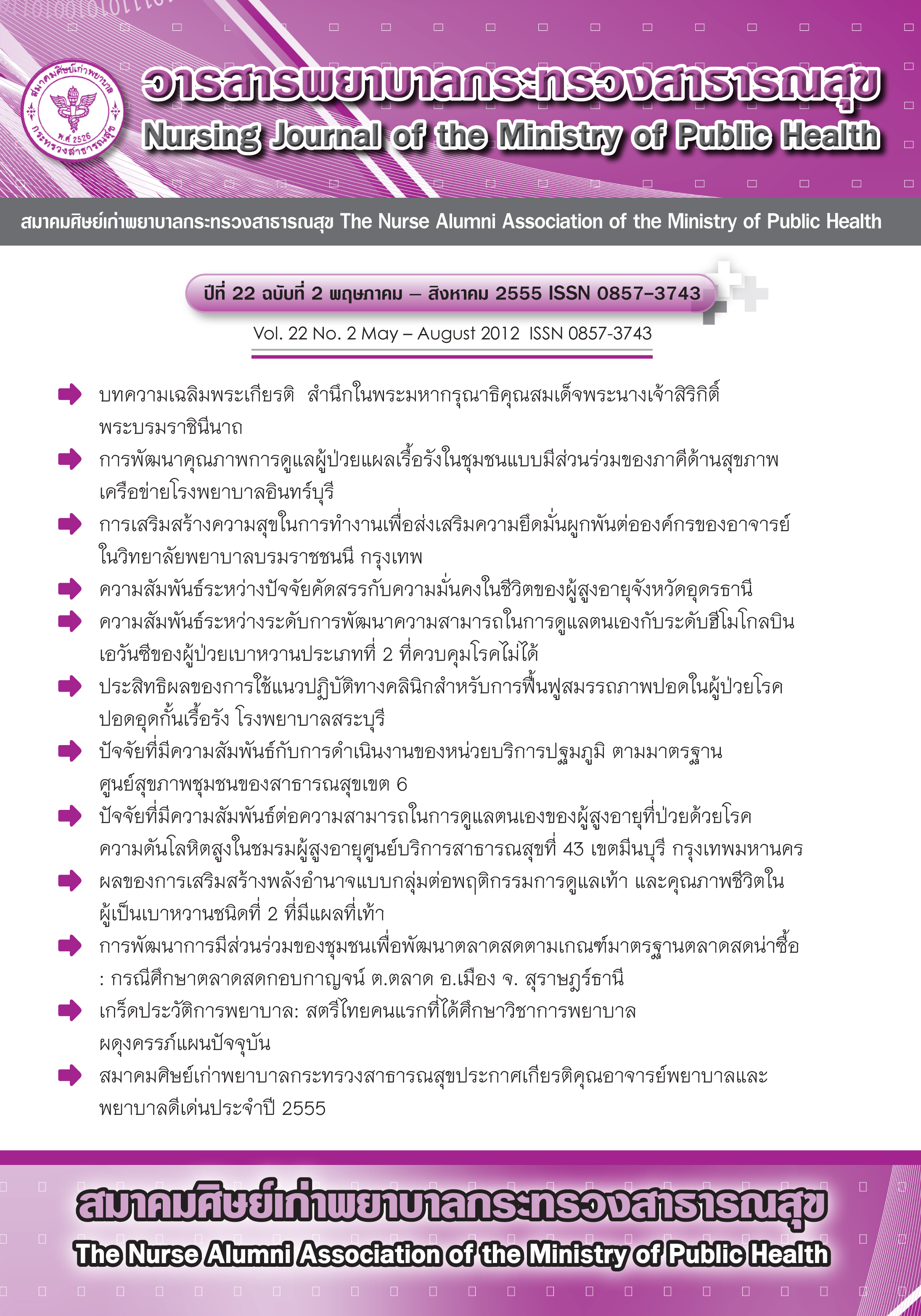การพัฒนาคุณภาพการดูแลผู้ป่วยแผลเรื้อรังในชุมชนแบบมีส่วนร่วมของภาคีด้านสุขภาพ เครือข่ายโรงพยาบาลอินทร์บุรี
Main Article Content
Abstract
บทคัดย่อ
การศึกษาครั้งนี้ เป็นวิจัยเชิงปฏิบัติการ (Action Research) มีวัตถุประสงค์เพื่อศึกษาสถานการณ์ปัญหาของการดูแลผู้ป่วยแผลเรื้อรัง ร่วมกับ การพัฒนาศักยภาพการดูแลผู้ป่วยแผลเรื้อรัง ของบุคลากรด้านสุขภาพในชุมชนและพัฒนาแนวทางการดูแลผู้ป่วยแผลเรื้อรังในชุมชนแบบมีส่วนร่วมโดยใช้กระบวนการ AIC และประเมินผลการใช้แนวทางการดูแลผู้ป่วยแผลเรื้อรังในชุมชนแบบมีส่วนร่วม ซึ่งผู้เข้าร่วมในโครงการวิจัยครั้งนี้ ประกอบด้วย พยาบาลวิชาชีพ นักสังคมสงเคราะห์ เจ้าหน้าที่ด้านสุขภาพ และอาสาสมัครสาธารณสุขของหน่วยบริการปฐมภูมิในเครือข่ายโรงพยาบาลอินทร์บุรี และนักพัฒนาชุมชนขององค์การบริหารส่วนตำบลในเขตอำเภออินทร์บุรี รวมถึงญาติผู้ดูแลผู้ป่วยแผลเรื้อรัง จำนวนทั้งหมด 64 คน ผู้ศึกษา ได้จัดประชุมเชิงปฏิบัติการเรื่องการดูแลผู้ป่วยแผลเรื้อรังในชุมชนแบบมีส่วนร่วมโดยใช้ระยะเวลา 2 วัน ประเมินผลการพัฒนาศักยภาพด้านความรู้ และความเชื่อมั่นในความสามารถของตนเองในการดูแลผู้ป่วยแผลเรื้อรัง โดยใช้แบบสอบถามซึ่งผ่านการตรวจสอบความตรงจากผู้เชี่ยวชาญ แล้วนำไปทดลองใช้ คำนวณหาความเที่ยงของแบบทดสอบความรู้ ด้วยวิธีของ คูเดอร์-ริชาร์ดสัน (KR-20) ได้เท่ากับ .69 ส่วนแบบประเมินความเชื่อมั่นในความสามารถของตนเอง คำนวณหาค่าสัมประสิทธิ์อัลฟ่าของครอนบาคได้เท่ากับ .78 วิเคราะห์ข้อมูลโดยใช้การทดสอบค่าที (Paired samples t-test) ส่วน ข้อมูลเชิงคุณภาพ ในการพัฒนาแนวทางปฏิบัติ การดูแลผู้ป่วยแผลเรื้อรังในชุมชนแบบมีส่วนร่วมโดยใช้กระบวนการ AIC และผลการดำเนินงานตามแนวทางปฏิบัติที่ได้ ใช้การวิเคราะห์เนื้อหา (Content analysis)
ผลการวิจัยพบว่า บุคลากรด้านสุขภาพขาดความรู้และความมั่นใจในการดูแลผู้ป่วยแผลเรื้อรังแต่ละชนิดที่มีความแตกต่างกัน วัสดุอุปกรณ์ในการทำความสะอาดแผลที่บ้านไม่เพียงพอและทั่วถึง ไม่มีเครือข่ายสนับสนุนหรืองบประมาณจากองค์กรภายนอก และขาดการสื่อสารที่จะเชื่อมโยงการดูแลที่บ้านอย่างต่อเนื่อง นำข้อมูลที่ได้มากำหนดเป็นแนวทางการพัฒนาคุณภาพการดูแลผู้ป่วยแผลเรื้อรังในชุมชน และพัฒนาเป็นแนวทางปฏิบัติ การดูแลผู้ป่วยแผลเรื้อรังในชุมชนแบบมีส่วนร่วมโดยใช้กระบวนการ AIC โดยเริ่มตั้งแต่การวางแผนจำหน่ายผู้ป่วยการส่งต่อผู้ป่วยไปยังชุมชน การประสานความช่วยเหลือผู้ป่วยด้านต่าง ๆ ทั้งจากภายในและจากองค์กรภายนอก การจัดตั้งกองทุนสนับสนุนวัสดุอุปกรณ์การดูแลผู้ป่วยแผลเรื้อรังที่บ้าน รวมทั้งการติดตามผู้ป่วยอย่างต่อเนื่อง โดยใช้การสื่อสารสองทางและเครือข่าย อสม.พี่เลี้ยง ส่วนการเปรียบเทียบคะแนนความรู้และความเชื่อมั่นในความสามารถของตนเอง ในการดูแลผู้ป่วยแผลเรื้อรังของพยาบาลวิชาชีพ พบว่าสูงกว่าก่อนปฏิบัติการอย่างมีนัยสำคัญทางสถิติที่ระดับ .05 และภายหลังการนำแนวทางปฏิบัติการดูแลผู้ป่วยแผลเรื้อรังในชุมชนแบบมีส่วนร่วม ไปทดลองใช้ พบว่าแนวทางปฏิบัติสามารถนำไปประยุกต์ใช้ได้ในสถานการณ์จริง มีกิจกรรมการดูแลผู้ป่วยที่ครอบคลุมตามประเด็นปัญหา โดยอาศัยการมีส่วนร่วมของทุกภาคส่วน ผู้ป่วยและครอบครัวมีความพึงพอใจในบริการพยาบาลและมีกำลังใจดีขึ้นการพัฒนาคุณภาพการดูแลผู้ป่วยแผลเรื้อรังในชุมชน โดยเทคนิคกระบวนการวางแผนแบบมีส่วนร่วม ช่วยให้บุคลากรด้านสุขภาพมีความรู้ ความมั่นใจ และเข้าใจถึงสภาพปัญหาของผู้ป่วยแผลเรื้อรังและครอบครัวได้มากขึ้น รวมทั้ง มีแนวทางปฏิบัติในการดูแลช่วยเหลือผู้ป่วยที่ชัดเจนสามารถนำไปใช้ได้จริง จึงสมควรนำไปประยุกต์ใช้กับโรงพยาบาลอื่นต่อไป
คำสำคัญ: ผู้ป่วยแผลเรื้อรัง, การมีส่วนร่วม
Abstract
This action research project aimed to improve the problem of caring for patients with chronic wounds. To achieve this, health care personnel in the community were trained to improve their care of chronic wound patients through a community participatory process using AIC and evaluate the care provided by a Community Health Network at Inburi Hospital. Participants comprised registered nurses, an almoner, health officials and volunteers from the primary care network at Inburi hospital and community developers from the Tambon Administrative Organization in Inburi District and caregivers of patients with chronic wounds. There were 64 participants in the study. The conference workshop on chronic wound care in the community lasted for 2 days. The training program focused on capacity development, improving knowledge and confidence in their ability to care for patients with chronic wounds, the use of a questionnaire that had been previously validated by experts for use in the trial. The reliability of questionnaire in terms of knowledge was tested using the Kuder-Richardson method (KR-20). The test showed a 0.69 level of confidence in their abilities by determination of Alfa coefficient of Cronbrach’s, was shown to be 0.78. The data were also analyzed by a paired samples t-test and qualitative data to develop guidelines for the care of chronic wound patients in the community by the AIC process using content analysis.
Before the development of the health care personnel lack the knowledge and confidence in caring for chronic wounds of different types. For example, materials to clean a wounds at home is often not adequate and thorough, there is no support network or organization outside of the budget and the lack of communication is linked to ongoing care at home. The collected data was used to determine the quality of care for chronic wound patients in the community and develop chronic wound care practices in community participation by the AIC by providing effective discharge planning for patients in the hospital, transferring patients to community, coordinating patients activities both inside and outs ide the organization. It is recommended that funding be made available for support materials for the care of chronic wound patients at home as well as continuous monitoring of patients using two-way communication and a network volunteers. An assessment was made to compare the scores on knowledge and confidence in their ability to care for patients with chronic wounds. It was found that the nurses’ scores were statistically significant at the .05 level of confidence after the guidelines for the care of chronic wound patients using a community participatory approach to an evaluation that can be applied in practical situations and to care for patients covered by the issues of participation in all sectors, patient and family satisfaction with nursing services and improved morale.
In short, a program to improve the quality of care for chronic wound patients in the community using a participatory planning process was able to improve the knowledge and confidence in health care personnel and access problems for patients with chronic wound and better family support. The study highlighted the importance of good quality guidelines for the care of patients based on participation in social networks.
Keywords : chronic wounds, participation in community health networks
Article Details
บทความและรายงานวิจัยในวารสารพยาบาลกระทรวงสาธารณสุข เป็นความคิดเห็นของ ผู้เขียน มิใช่ของคณะผู้จัดทำ และมิใช่ความรับผิดชอบของสมาคมศิษย์เก่าพยาบาลกระทรวงสาธารณสุข ซึ่งสามารถนำไปอ้างอิงได้
